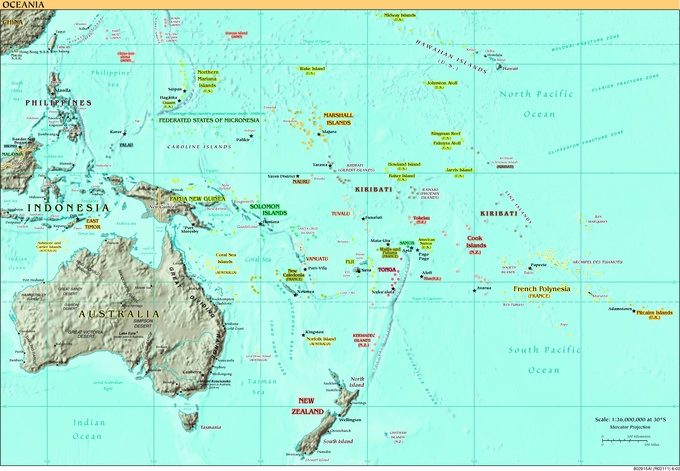26.7: Modern Oceanic Art
- Page ID
- 53113
\( \newcommand{\vecs}[1]{\overset { \scriptstyle \rightharpoonup} {\mathbf{#1}} } \)
\( \newcommand{\vecd}[1]{\overset{-\!-\!\rightharpoonup}{\vphantom{a}\smash {#1}}} \)
\( \newcommand{\dsum}{\displaystyle\sum\limits} \)
\( \newcommand{\dint}{\displaystyle\int\limits} \)
\( \newcommand{\dlim}{\displaystyle\lim\limits} \)
\( \newcommand{\id}{\mathrm{id}}\) \( \newcommand{\Span}{\mathrm{span}}\)
( \newcommand{\kernel}{\mathrm{null}\,}\) \( \newcommand{\range}{\mathrm{range}\,}\)
\( \newcommand{\RealPart}{\mathrm{Re}}\) \( \newcommand{\ImaginaryPart}{\mathrm{Im}}\)
\( \newcommand{\Argument}{\mathrm{Arg}}\) \( \newcommand{\norm}[1]{\| #1 \|}\)
\( \newcommand{\inner}[2]{\langle #1, #2 \rangle}\)
\( \newcommand{\Span}{\mathrm{span}}\)
\( \newcommand{\id}{\mathrm{id}}\)
\( \newcommand{\Span}{\mathrm{span}}\)
\( \newcommand{\kernel}{\mathrm{null}\,}\)
\( \newcommand{\range}{\mathrm{range}\,}\)
\( \newcommand{\RealPart}{\mathrm{Re}}\)
\( \newcommand{\ImaginaryPart}{\mathrm{Im}}\)
\( \newcommand{\Argument}{\mathrm{Arg}}\)
\( \newcommand{\norm}[1]{\| #1 \|}\)
\( \newcommand{\inner}[2]{\langle #1, #2 \rangle}\)
\( \newcommand{\Span}{\mathrm{span}}\) \( \newcommand{\AA}{\unicode[.8,0]{x212B}}\)
\( \newcommand{\vectorA}[1]{\vec{#1}} % arrow\)
\( \newcommand{\vectorAt}[1]{\vec{\text{#1}}} % arrow\)
\( \newcommand{\vectorB}[1]{\overset { \scriptstyle \rightharpoonup} {\mathbf{#1}} } \)
\( \newcommand{\vectorC}[1]{\textbf{#1}} \)
\( \newcommand{\vectorD}[1]{\overrightarrow{#1}} \)
\( \newcommand{\vectorDt}[1]{\overrightarrow{\text{#1}}} \)
\( \newcommand{\vectE}[1]{\overset{-\!-\!\rightharpoonup}{\vphantom{a}\smash{\mathbf {#1}}}} \)
\( \newcommand{\vecs}[1]{\overset { \scriptstyle \rightharpoonup} {\mathbf{#1}} } \)
\( \newcommand{\vecd}[1]{\overset{-\!-\!\rightharpoonup}{\vphantom{a}\smash {#1}}} \)
\(\newcommand{\avec}{\mathbf a}\) \(\newcommand{\bvec}{\mathbf b}\) \(\newcommand{\cvec}{\mathbf c}\) \(\newcommand{\dvec}{\mathbf d}\) \(\newcommand{\dtil}{\widetilde{\mathbf d}}\) \(\newcommand{\evec}{\mathbf e}\) \(\newcommand{\fvec}{\mathbf f}\) \(\newcommand{\nvec}{\mathbf n}\) \(\newcommand{\pvec}{\mathbf p}\) \(\newcommand{\qvec}{\mathbf q}\) \(\newcommand{\svec}{\mathbf s}\) \(\newcommand{\tvec}{\mathbf t}\) \(\newcommand{\uvec}{\mathbf u}\) \(\newcommand{\vvec}{\mathbf v}\) \(\newcommand{\wvec}{\mathbf w}\) \(\newcommand{\xvec}{\mathbf x}\) \(\newcommand{\yvec}{\mathbf y}\) \(\newcommand{\zvec}{\mathbf z}\) \(\newcommand{\rvec}{\mathbf r}\) \(\newcommand{\mvec}{\mathbf m}\) \(\newcommand{\zerovec}{\mathbf 0}\) \(\newcommand{\onevec}{\mathbf 1}\) \(\newcommand{\real}{\mathbb R}\) \(\newcommand{\twovec}[2]{\left[\begin{array}{r}#1 \\ #2 \end{array}\right]}\) \(\newcommand{\ctwovec}[2]{\left[\begin{array}{c}#1 \\ #2 \end{array}\right]}\) \(\newcommand{\threevec}[3]{\left[\begin{array}{r}#1 \\ #2 \\ #3 \end{array}\right]}\) \(\newcommand{\cthreevec}[3]{\left[\begin{array}{c}#1 \\ #2 \\ #3 \end{array}\right]}\) \(\newcommand{\fourvec}[4]{\left[\begin{array}{r}#1 \\ #2 \\ #3 \\ #4 \end{array}\right]}\) \(\newcommand{\cfourvec}[4]{\left[\begin{array}{c}#1 \\ #2 \\ #3 \\ #4 \end{array}\right]}\) \(\newcommand{\fivevec}[5]{\left[\begin{array}{r}#1 \\ #2 \\ #3 \\ #4 \\ #5 \\ \end{array}\right]}\) \(\newcommand{\cfivevec}[5]{\left[\begin{array}{c}#1 \\ #2 \\ #3 \\ #4 \\ #5 \\ \end{array}\right]}\) \(\newcommand{\mattwo}[4]{\left[\begin{array}{rr}#1 \amp #2 \\ #3 \amp #4 \\ \end{array}\right]}\) \(\newcommand{\laspan}[1]{\text{Span}\{#1\}}\) \(\newcommand{\bcal}{\cal B}\) \(\newcommand{\ccal}{\cal C}\) \(\newcommand{\scal}{\cal S}\) \(\newcommand{\wcal}{\cal W}\) \(\newcommand{\ecal}{\cal E}\) \(\newcommand{\coords}[2]{\left\{#1\right\}_{#2}}\) \(\newcommand{\gray}[1]{\color{gray}{#1}}\) \(\newcommand{\lgray}[1]{\color{lightgray}{#1}}\) \(\newcommand{\rank}{\operatorname{rank}}\) \(\newcommand{\row}{\text{Row}}\) \(\newcommand{\col}{\text{Col}}\) \(\renewcommand{\row}{\text{Row}}\) \(\newcommand{\nul}{\text{Nul}}\) \(\newcommand{\var}{\text{Var}}\) \(\newcommand{\corr}{\text{corr}}\) \(\newcommand{\len}[1]{\left|#1\right|}\) \(\newcommand{\bbar}{\overline{\bvec}}\) \(\newcommand{\bhat}{\widehat{\bvec}}\) \(\newcommand{\bperp}{\bvec^\perp}\) \(\newcommand{\xhat}{\widehat{\xvec}}\) \(\newcommand{\vhat}{\widehat{\vvec}}\) \(\newcommand{\uhat}{\widehat{\uvec}}\) \(\newcommand{\what}{\widehat{\wvec}}\) \(\newcommand{\Sighat}{\widehat{\Sigma}}\) \(\newcommand{\lt}{<}\) \(\newcommand{\gt}{>}\) \(\newcommand{\amp}{&}\) \(\definecolor{fillinmathshade}{gray}{0.9}\)Pacific Arts Festival
The Pacific Arts Festival celebrates the arts of indigenous cultures in the Oceanic region.
Describe the significance of the Pacific Arts Festival
Key Points
- The Festival of Pacific Arts, or Pacific Arts Festival, is a traveling festival hosted every four years by a different country in Oceania.
- The Pacific Arts Festival was conceived by the Secretariat of the Pacific Community as a means to stem the erosion of traditional cultural practices by sharing and exchanging culture at each festival.
- By its vastness, the Pacific Ocean inhibits social and cultural interchange between the inhabitants of its island countries. The festival is not a competition but a cultural exchange, and it serves to both reunite people and reinforce regional identity and mutual appreciation of Pacific-wide culture.
- Participating countries select artist-delegates to represent the nation at this crossroads of cultures, which is considered a great honor.
Key Terms
- Oceania: A geographical region composed of many islands (Melanesia, Micronesia, and Polynesia) plus Australasia; it is located between Asia, Antarctica, and the Americas.
Introduction
The Festival of Pacific Arts, or Pacific Arts Festival, is a traveling festival hosted every four years by a different country in Oceania. It was conceived by the Secretariat of the Pacific Community, former South Pacific Commission, as a means to stem the erosion of traditional cultural practices by sharing and exchanging culture at each festival. The major theme of the festival is traditional song and dance. The first festival was held in May of 1972 in Suva, Fuji, and it has been held roughly every four years since in countries around the Pacific. The 2012 Festival was hosted by the Soloman Islands from July 1–14 with the theme of “Culture in Harmony with Nature.” From May 22 to June 4, 2016, the 12th ever Festival of Pacific Arts was held in Hagåtña, Guam, with the theme of “What We Own, What We Have, What We Share, United Voices of the PACIFIC.” The next Festival will take place in 2020 in Hawaii.

The Festival’s Value and Purpose
By its vastness, the Pacific Ocean inhibits social and cultural interchange between the inhabitants of its island countries. The festival is not a competition but a cultural exchange, and it serves to both reunite people and reinforce regional identity and mutual appreciation of Pacific-wide culture. Participating countries select artist-delegates to represent the nation at this crossroads of cultures, which is considered a great honor.
The Pacific Cultural Council selects the host country, recognizing that each participating country desires the opportunity to showcase its unique indigenous culture by hosting the festival. Host selection is based on principles of equity, and preference is given to countries which have not yet hosted. The festival’s host country pays participants’ costs of local travel, accommodation, meals, and other forms of hospitality. Entry to all artistic events is free to the public, thereby maximizing cultural outreach and inclusion.
In 2008, about 2,000 artists attended the Festival of Pacific Arts from the following participating countries: American Samoa, Australia, Cook Islands, Easter Island, Federated States of Micronesia, Fiji, French Polynesia, Guam, Hawaii, Kiribati, Marshall Islands, Nauru, New Caledonia, New Zealand, Niue, Norfolk Island, Northern Mariana Islands, Palau, Papua New Guinea, Pitcairn Islands, Sāmoa, Solomon Islands, Tokelau, Tonga, Tuvalu, Vanuatu, and Wallis and Futuna. Taiwan was allowed to send a delegation of 80 performers and artists, most of whom were Taiwanese aborigines, to the Festival of Pacific Arts for the first time in 2008.
- Curation and Revision. Provided by: Boundless.com. License: CC BY-SA: Attribution-ShareAlike
- Pacific Arts Festival. Provided by: Wikipedia. Located at: en.Wikipedia.org/wiki/Pacific_Arts_Festival. License: CC BY-SA: Attribution-ShareAlike
- Oceania. Provided by: Wiktionary. Located at: en.wiktionary.org/wiki/Oceania. License: CC BY-SA: Attribution-ShareAlike
- Oceania. Provided by: Wikipedia. Located at: en.Wikipedia.org/wiki/File:Oceania.jpg. License: Public Domain: No Known Copyright


